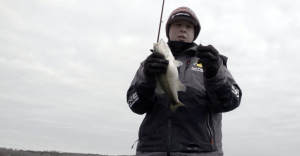Deep-water jigging for winter bass, especially in highland reservoirs, has become a highly effective strategy for targeting fish at depths beyond 70 feet. This advanced method combines specialized lures and modern technology, transforming the traditional approach to winter bass fishing. Using fast-falling jigs and forward-facing sonar, anglers can efficiently locate and target bass feeding on roaming schools of shad.

Optimizing Deep-Water Tactics
Success in deep-water jigging relies on precision and efficiency, especially in winter when bass frequent deeper, clearer waters. Key areas to target include the mouths of long pockets where they meet the main lake—prime wintering zones for bass. Fast-falling lures, such as a 1-1/4 ounce jigging lure, are essential. The rapid descent increases the likelihood of entering the small, dynamic strike zone where bass actively hunt, maximizing the chances of a successful catch.
Jigging Lures in Action
Heavy jigs excel in deep-water scenarios due to their versatility and effectiveness. These lures generate erratic, side-to-side movements, closely mimicking injured baitfish. Alternatively, subtle movements can imitate a hovering minnow, ideal for finicky fish. Forward-facing sonar is integral to this approach, allowing anglers to spot fish in real time and cast precisely to their location rather than relying solely on vertical jigging. This horizontal strategy ensures that the lure reaches actively moving bass with high accuracy.
Choosing the Right Jigging Lure
Selecting the right jig depends on water depth and fish behavior. Lighter jigs, such as a 7/8-ounce model, work well in moderate depths, while heavier versions are better suited for deeper water. Advanced features like beefed-up hooks, built-in swivels, and split rings enhance hook sets and reduce leverage, crucial for landing larger fish. Adjusting lure size and profile based on conditions and baitfish size can significantly improve results.
Gear Setup for Precision and Efficiency
A well-matched rod and line setup is vital for effective deep-water jigging. A 7’1” medium power spinning rod paired with an 8-pound fluorocarbon leader and braided mainline offers the perfect balance of sensitivity and strength. The thin fluorocarbon leader minimizes visibility and ensures a direct connection to the jig, making it easier to detect subtle bites in cold, deep water. This combination helps the lure fall quickly and naturally, crucial for targeting bass in deeper zones.
Technology: The Game-Changer
Advancements in fishing technology, particularly forward-facing sonar, have revolutionized deep-water jigging. Tools like modern sonar systems provide real-time data on fish movements, allowing for dynamic adjustments in technique. This technology eliminates much of the guesswork, enabling precise lure placement and increasing catch rates. Using sonar to guide jigging actions ensures that the lure reaches the exact location of the fish, a key advantage in deep water.
Versatility Across Species
While this deep-water jigging technique is highly effective for winter bass, it also applies to other species such as walleye, pike, and salmon. The principles of using fast-falling lures, accurate sonar-guided casting, and strategic retrieval are universal. This method can enhance success in various deep-water fishing scenarios, making it a valuable addition to any angler’s toolkit.
The Future of Deep-Water Jigging
Deep-water jigging represents a significant advancement in winter fishing strategies. Combining modern technology with specialized gear and refined techniques sets a new standard for targeting bass and other gamefish in challenging conditions. As forward-facing sonar and other tools become more accessible, deep-water jigging offers anglers a powerful way to improve their success, transforming winter fishing on highland reservoirs and beyond.
Image/Source: Wired2Fish





